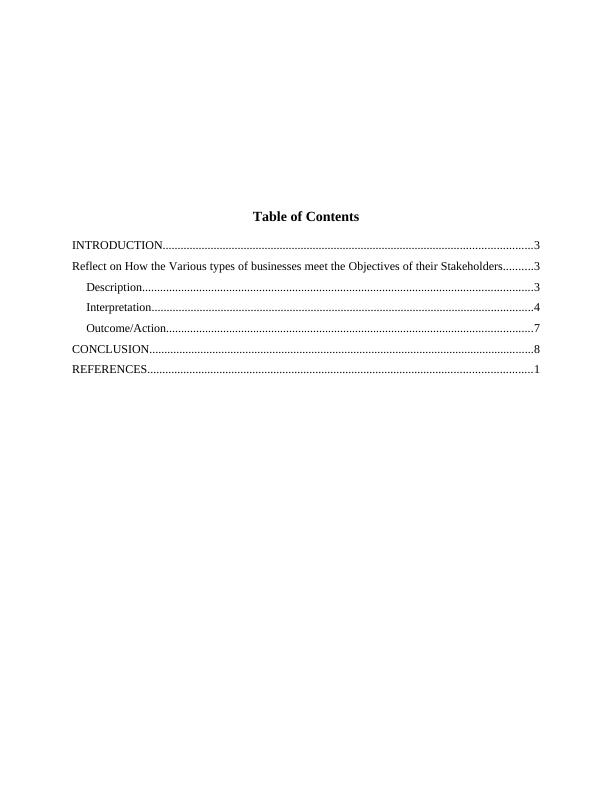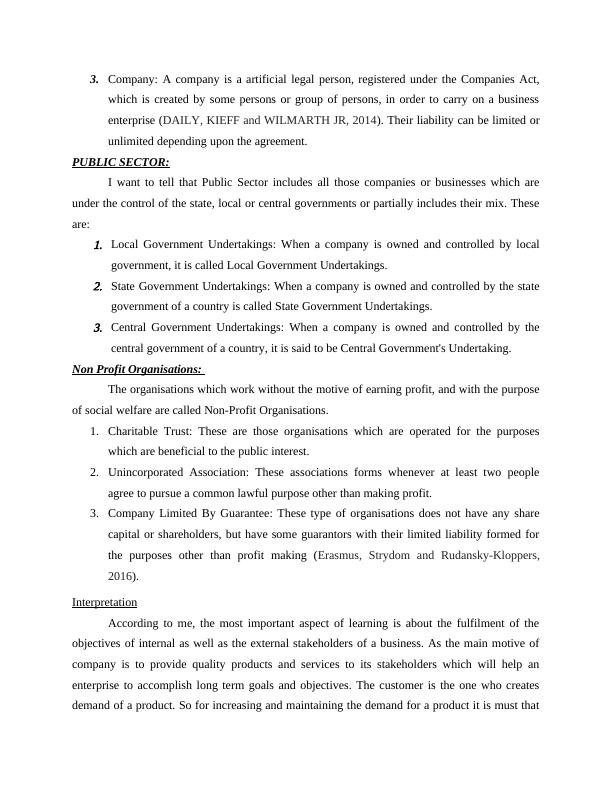Introduction to Business Environment Assignment (Doc)
12 Pages2677 Words196 Views
Added on 2020-11-12
Introduction to Business Environment Assignment (Doc)
Added on 2020-11-12
ShareRelated Documents
Introduction to
Business
Environment
Business
Environment

Table of Contents
INTRODUCTION...........................................................................................................................3
Reflect on How the Various types of businesses meet the Objectives of their Stakeholders..........3
Description..................................................................................................................................3
Interpretation...............................................................................................................................4
Outcome/Action..........................................................................................................................7
CONCLUSION................................................................................................................................8
REFERENCES................................................................................................................................1
INTRODUCTION...........................................................................................................................3
Reflect on How the Various types of businesses meet the Objectives of their Stakeholders..........3
Description..................................................................................................................................3
Interpretation...............................................................................................................................4
Outcome/Action..........................................................................................................................7
CONCLUSION................................................................................................................................8
REFERENCES................................................................................................................................1

INTRODUCTION
Business Environment refers to all the sum of all factors such as the internal and external
that affects the business whether in a positive way or in a negative way. Every business has to
meet the objectives of their stakeholders. Stakeholders can be defined as a person, group or
organisation that has its interest or particular concern in the organisation (Briscoe, Tarique and
Schuler, 2012). Stakeholders can affect, or be affected by the actions, objectives or policies of
the organisation.
Reflect on How the Various types of businesses meet the Objectives of their
Stakeholders
Description
This report is based on different types of organisation and its role about how to fulfil needs
and objectives of stakeholders easily. Business in accordance to the Legal Forms can be divided
in three forms:
PRIVATE SECTOR:
According to my knowledge, private sector is that part of country's economy that is run
by some or a single individual with the Objective of making Profit. The Government has no
control over its functioning. Private Sectors can be further classified into the following
categories:
1. Sole Proprietorship: When only one individual is the owner of the business, and is solely
responsible for all the profits and losses earned by the business is Sole proprietorship. He
takes all the decisions whether financial, or managerial or any other related to the
business and is solely responsible for the consequences resulting out of it (Colombo and
et. al., 2012).
2. Partnership: It refers to that form of business in which the number of owners are more
than one. The maximum number of partners is 20 in banking business and rest all other
types of businesses it is limited only to 10 and the minimum is two. Their liability in
unlimited, which mean to say that if the company occurs heavy loss than it will be
compensated by the sale of their personal assets also.
Business Environment refers to all the sum of all factors such as the internal and external
that affects the business whether in a positive way or in a negative way. Every business has to
meet the objectives of their stakeholders. Stakeholders can be defined as a person, group or
organisation that has its interest or particular concern in the organisation (Briscoe, Tarique and
Schuler, 2012). Stakeholders can affect, or be affected by the actions, objectives or policies of
the organisation.
Reflect on How the Various types of businesses meet the Objectives of their
Stakeholders
Description
This report is based on different types of organisation and its role about how to fulfil needs
and objectives of stakeholders easily. Business in accordance to the Legal Forms can be divided
in three forms:
PRIVATE SECTOR:
According to my knowledge, private sector is that part of country's economy that is run
by some or a single individual with the Objective of making Profit. The Government has no
control over its functioning. Private Sectors can be further classified into the following
categories:
1. Sole Proprietorship: When only one individual is the owner of the business, and is solely
responsible for all the profits and losses earned by the business is Sole proprietorship. He
takes all the decisions whether financial, or managerial or any other related to the
business and is solely responsible for the consequences resulting out of it (Colombo and
et. al., 2012).
2. Partnership: It refers to that form of business in which the number of owners are more
than one. The maximum number of partners is 20 in banking business and rest all other
types of businesses it is limited only to 10 and the minimum is two. Their liability in
unlimited, which mean to say that if the company occurs heavy loss than it will be
compensated by the sale of their personal assets also.

3. Company: A company is a artificial legal person, registered under the Companies Act,
which is created by some persons or group of persons, in order to carry on a business
enterprise (DAILY, KIEFF and WILMARTH JR, 2014). Their liability can be limited or
unlimited depending upon the agreement.
PUBLIC SECTOR:
I want to tell that Public Sector includes all those companies or businesses which are
under the control of the state, local or central governments or partially includes their mix. These
are: 1. Local Government Undertakings: When a company is owned and controlled by local
government, it is called Local Government Undertakings.2. State Government Undertakings: When a company is owned and controlled by the state
government of a country is called State Government Undertakings.3. Central Government Undertakings: When a company is owned and controlled by the
central government of a country, it is said to be Central Government's Undertaking.
Non Profit Organisations:
The organisations which work without the motive of earning profit, and with the purpose
of social welfare are called Non-Profit Organisations.
1. Charitable Trust: These are those organisations which are operated for the purposes
which are beneficial to the public interest.
2. Unincorporated Association: These associations forms whenever at least two people
agree to pursue a common lawful purpose other than making profit.
3. Company Limited By Guarantee: These type of organisations does not have any share
capital or shareholders, but have some guarantors with their limited liability formed for
the purposes other than profit making (Erasmus, Strydom and Rudansky-Kloppers,
2016).
Interpretation
According to me, the most important aspect of learning is about the fulfilment of the
objectives of internal as well as the external stakeholders of a business. As the main motive of
company is to provide quality products and services to its stakeholders which will help an
enterprise to accomplish long term goals and objectives. The customer is the one who creates
demand of a product. So for increasing and maintaining the demand for a product it is must that
which is created by some persons or group of persons, in order to carry on a business
enterprise (DAILY, KIEFF and WILMARTH JR, 2014). Their liability can be limited or
unlimited depending upon the agreement.
PUBLIC SECTOR:
I want to tell that Public Sector includes all those companies or businesses which are
under the control of the state, local or central governments or partially includes their mix. These
are: 1. Local Government Undertakings: When a company is owned and controlled by local
government, it is called Local Government Undertakings.2. State Government Undertakings: When a company is owned and controlled by the state
government of a country is called State Government Undertakings.3. Central Government Undertakings: When a company is owned and controlled by the
central government of a country, it is said to be Central Government's Undertaking.
Non Profit Organisations:
The organisations which work without the motive of earning profit, and with the purpose
of social welfare are called Non-Profit Organisations.
1. Charitable Trust: These are those organisations which are operated for the purposes
which are beneficial to the public interest.
2. Unincorporated Association: These associations forms whenever at least two people
agree to pursue a common lawful purpose other than making profit.
3. Company Limited By Guarantee: These type of organisations does not have any share
capital or shareholders, but have some guarantors with their limited liability formed for
the purposes other than profit making (Erasmus, Strydom and Rudansky-Kloppers,
2016).
Interpretation
According to me, the most important aspect of learning is about the fulfilment of the
objectives of internal as well as the external stakeholders of a business. As the main motive of
company is to provide quality products and services to its stakeholders which will help an
enterprise to accomplish long term goals and objectives. The customer is the one who creates
demand of a product. So for increasing and maintaining the demand for a product it is must that

End of preview
Want to access all the pages? Upload your documents or become a member.
Related Documents
Business and the Business Environment Assignment - Apple Inclg...
|17
|4950
|88
How Business Operatelg...
|13
|932
|70
(solved) Business Environment of Morrisonslg...
|15
|4622
|61
Business and Business Environmentlg...
|11
|3311
|63
Types and Purposes of Organizations and their Legal Structureslg...
|3
|1833
|137
Business Entities in Malaysia - Doclg...
|11
|3108
|77
